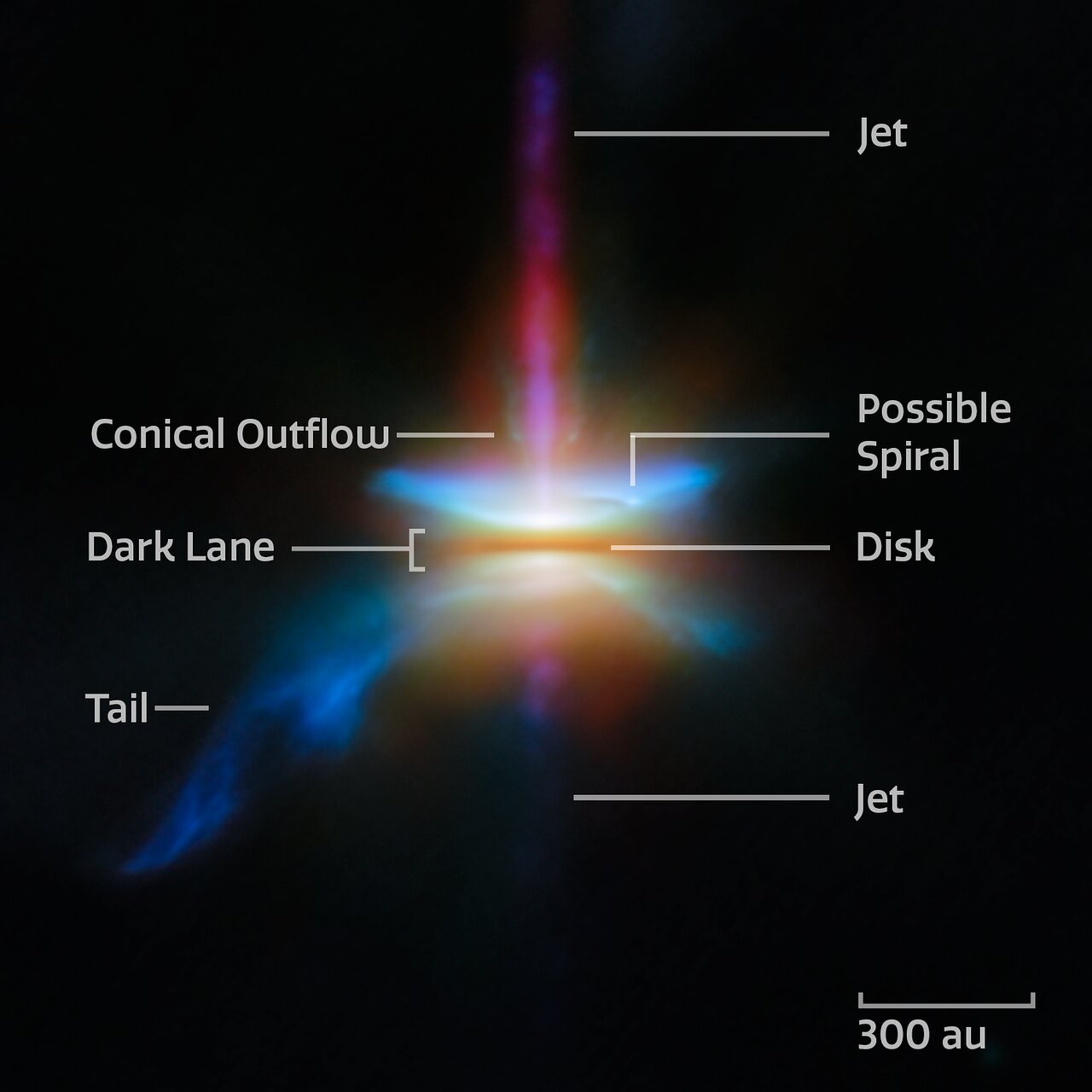About the Object
| Name: | HH 30 | |
|---|---|---|
| Distance: |
477 light years | |
| Category: | MIRI NIRCam Picture of the Month Stars | |
Webb spies a multifaceted disc
This new NASA/ESA/CSA James Webb Space Telescope Picture of the Month presents HH 30 in unprecedented resolution. This target is an edge-on protoplanetary disc that is surrounded by jets and a disc wind, and is located in the dark cloud LDN 1551 in the Taurus Molecular Cloud.
Herbig-Haro objects are small nebulae found in star formation regions, marking the locations where gas outflowing from young stars is heated into luminescence by shockwaves. HH 30 is an example of where this outflowing gas takes the form of a narrow jet. The source star is located on one end of the jet, hidden behind an edge-on protoplanetary disc that the star is illuminating.
HH 30 is of particular interest to astronomers. In fact, the HH 30 disc is considered the prototype of an edge-on disc, thanks to its early discovery with the NASA/ESA Hubble Space Telescope. Discs seen from this view are a unique laboratory to study the settling and drift of dust grains.
An international team of astronomers have used Webb to investigate the target in unprecedented detail. By combining Webb’s observations with those from the Hubble Space Telescope and the Atacama Large Millimeter/submillimeter Array (ALMA), the team was able to study the multiwavelength disc appearance of the system and its dynamic structures.
These Webb observations were taken as part of the Webb GO programme #2562 (PI F. Ménard, K. Stapelfeldt), which aims to understand how dust evolves in edge-on discs like HH 30. Combined with the keen radio-wavelength eyes of ALMA, these observations show that large dust grains must migrate within the disc and settle in a thin layer. The creation of a narrow, dense layer of dust is an important stage in the process of planet formation. In this dense region, dust grains clump together to form pebbles and eventually planets themselves.
In addition to the behaviour of dust grains, the Webb, Hubble, and ALMA images reveal several distinct structures that are nested within one another. Emerging at a 90-degree angle from the narrow central disc is a high-velocity jet of gas. The Webb data showed that clumps of gas within the jet are moving at 121 kilometres per second. The narrow jet is surrounded by a wider, cone-shaped outflow. Enclosing the conical outflow is a broad nebula that reflects the light from the young star that is embedded within the disc. This structure shows a hint of a spiral, similar to what is seen in other young protoplanetary discs, as well as a ‘tail’-like feature that extends to one side. While the origins of these features have yet to be determined, together they reveal HH 30 to be a dynamic site of planet formation.
[Image Description: A close-in image of protoplanetary disc HH 30. Parts of the image are labelled “Jet” (above and below the disc), “Conical Outflow”, “Possible Spiral”, “Dark Lane”, “Disk”, and “Tail”. A scale marker in the bottom-left is labelled “300 au”; this is a little wider than the disc itself, but less wide than the conical outflows above and below the disc.]
Links
Credit:ESA/Webb, NASA & CSA, Tazaki et al.
About the Image
| Id: | potm2501c | |
|---|---|---|
| Type: | Chart | |
| Release date: | 4 February 2025, 10:00 | |
| Size: | 1580 x 1580 px | |


